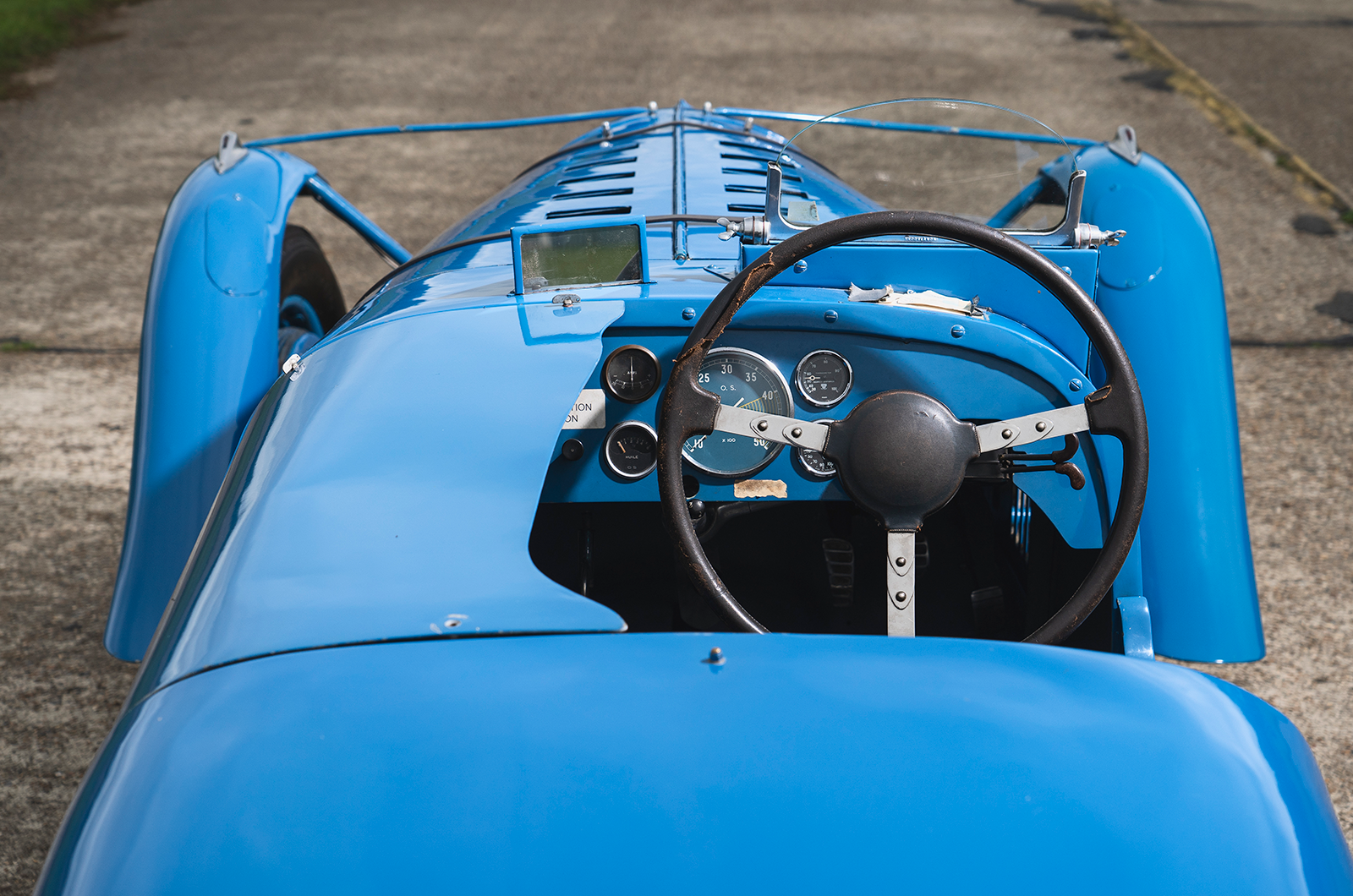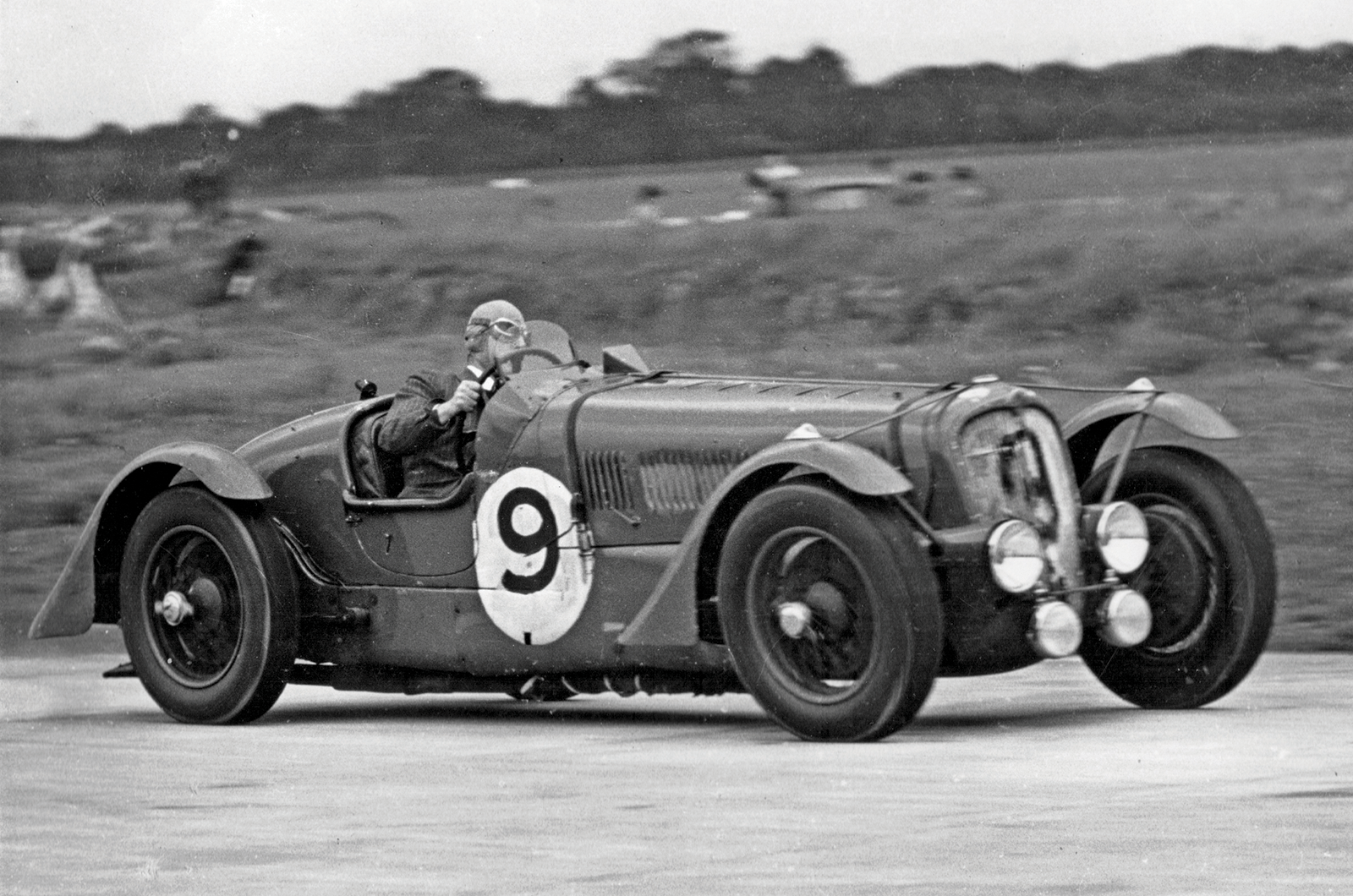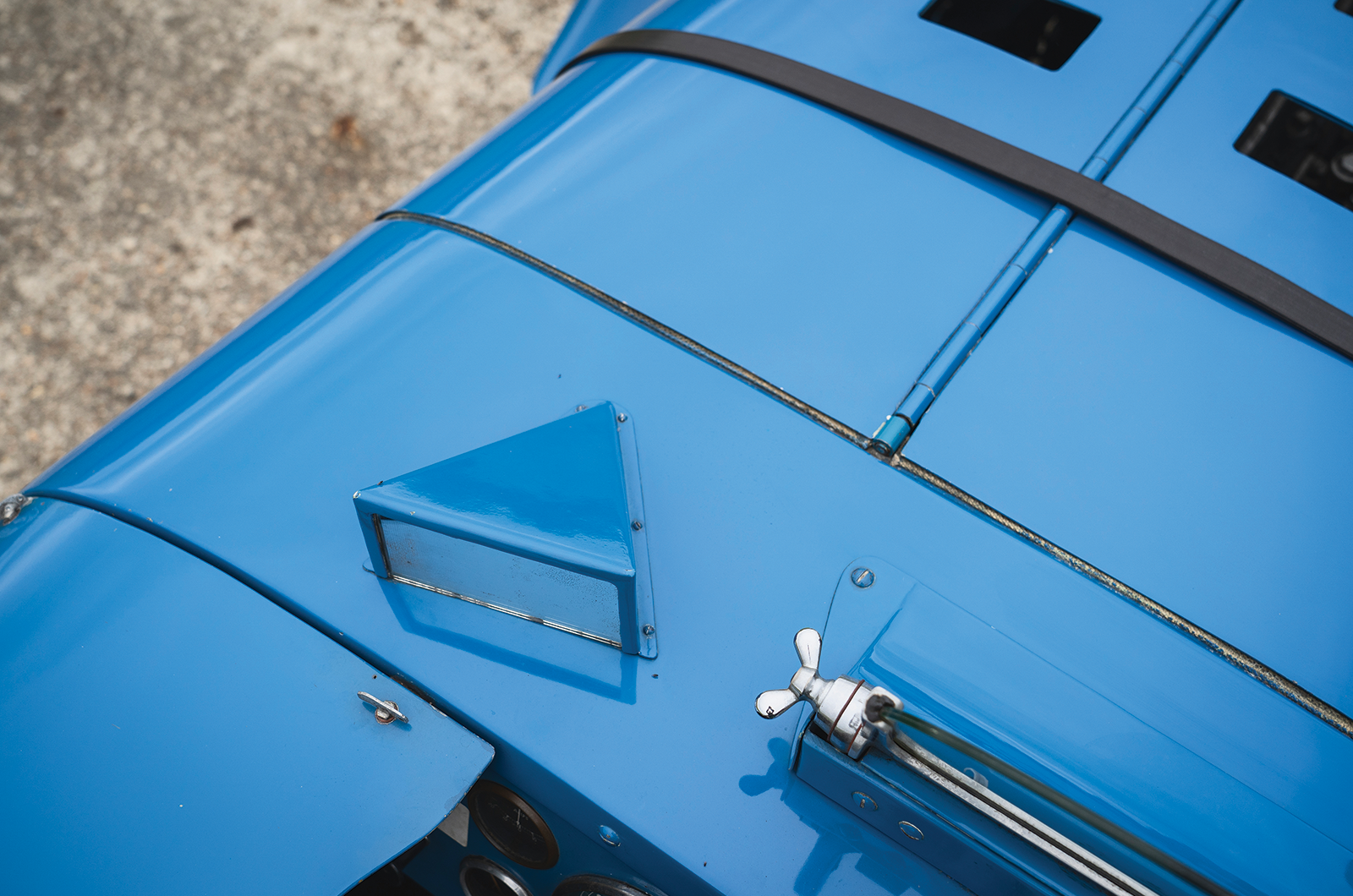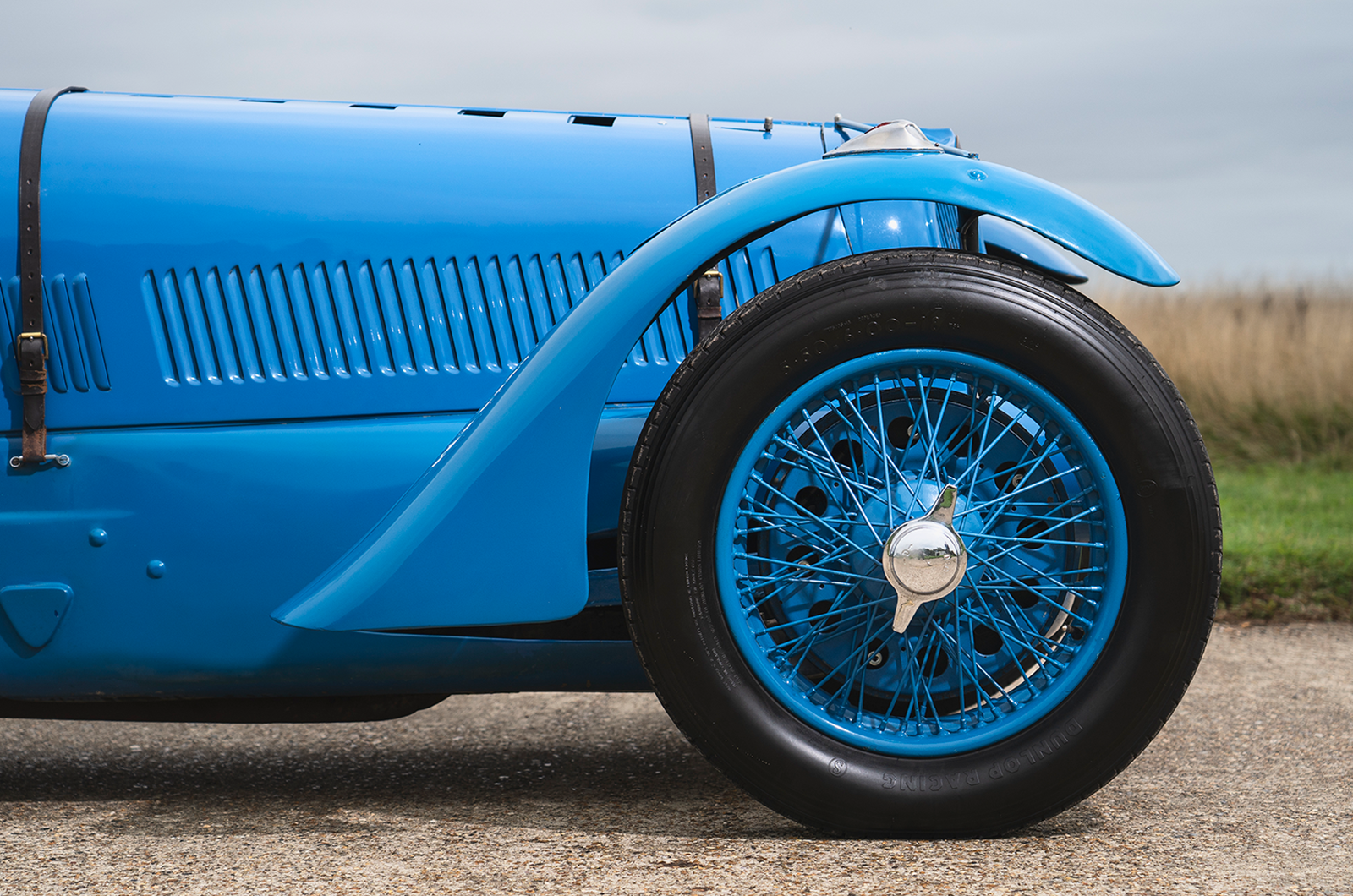The Major had a superb collection of famous cars, and behind the scenes he was also responsible for financing most of Ecurie Ecosse’s activities.
When he died in 1970, everything was auctioned in aid of the RNLI.
Rob hastened to bid for the Delahaye 135CS, buying it back for the third time.
It was in a poor state, so Rob’s race mechanic, John Chisman, embarked on a superb and painstaking three-year rebuild.
The Delahaye 135CS wears big wire wheels, also painted French Racing Blue
After enjoying 47188 for 30 more years – and getting Stirling Moss to drive it for him in a Le Mans historic race – Rob died in 2002.
But it remained in the family, looked after by his son Robbie and exhibited in several museums.
Recently, this great and famous car found a new home, after it went under the hammer with RM Sotheby’s at The Peninsula London hotel on 2 November 2024.
Robbie Walker graciously suggested that I should sample the Delahaye before it went to auction.
Struts across the Delahaye’s nose help to steady the wings
I approached it with some trepidation, because here is a significant and very valuable motor car of impeccable provenance.
With its remarkable history, it deserves respect. But I needn’t have worried, for 47188 proved to be friendly and eminently usable.
It looks wonderful in its correct French Racing Blue: a classic, long-nosed 1930s sports-racing car, with low-set headlights faired-in beside the Delahaye grille, the lines of the deep chassis frame visible beneath the panelling.
Rob Walker looked after this Delahaye 135CS long after he stopped racing it
The leather-strapped bonnet has cooling vents that can be slid open and shut, and the wings, as on other French sports-racers of the period, have fairings behind the wheels.
The drilled brake drums, with cooling scoops, are blue also, as are the big wire wheels.
Climbing aboard is difficult, because the gap between the seat and the big sprung-spoke steering wheel (still wearing its worn original leather) is tight.
It’s best to perch on the back of the cockpit and slide in, legs straight.
The Delahaye 135CS has bonnet vents which slide open and shut
The next problem is that the pedals are very small, and close together.
Unless you have dainty feet you must wear shoes without welts.
Otherwise, as you come off full throttle to hit the brake, you can get your foot caught behind the brake pedal: rather worrying as a corner rushes up.
Once you are in, however, the cockpit is comfortable, even though there are just plain, flat cushions forming a bench seat with no support.
The Delahaye 135CS is not intimidating to drive
The dash is straightforward, with the usual small gauges.
The rev counter reads to 6000rpm, but the red zone starting at 4000rpm reminds you that this is a low-revving engine.
Sprouting from the dash is the tiny four-fingered gate for the Cotal ’box.
Underneath, almost out of sight, is a conventional-looking lever, with three positions: forward, neutral and reverse.
Triple Solex carburettors and exhaust sit on the same side of the cylinder head
Check that it is in neutral, jab the starter and the big engine fires at once, settling to a calm burble.
Select position 1 on the little gate, push the clutch, select Forward on the gearlever, let in the clutch in the usual way, and you’re off.
Thereafter you can forget the clutch, and change up and down using the little switch.
The tremendous torque of the big, grumbling ‘six’ makes the Delahaye very easy to drive.
‘The Delahaye’s rev counter reads to 6000rpm, but the red zone starting at 4000rpm reminds you that this is a low-revving engine’
It copes well with slow traffic, helped by a modern electric fan.
On the open road, flicking the switch to the next gear at 4000rpm lands you back at the peak of the torque curve and it accelerates relentlessly.
The brake pedal has a disconcertingly long travel, but, once you reach the point where the cable-operated brakes actually come on, they give confidence.
The Delahaye 135CS has independent suspension up front and externally mounted leaf springs at the rear
The real surprise is the handling.
I expected the steering of this big car to be heavy, but once you’re moving it is light and precise, and the ride is no harsher than you would expect from a 1930s sports car.
You can push it hard into a corner before prodding that long brake pedal, and the Delahaye answers the helm without understeer.
It is nicely balanced, and you feel you can place it to the inch.
The delicate shifter for the Delahaye’s Cotal electromagnetic gearbox
Back on the power, the back digs in as the torque pushes you up the road, helped by the effortless changes from the Cotal ’box.
In its day, what a satisfying long-distance racer this must have been.
In fact, with that long bonnet pointed down a straight road, as the revs rumble up to 4000 and you flick the switch into top, you are back in the heady days before the war.
Hopefully this Delahaye 135CS will return to Goodwood and Le Mans in the future
Over your shirt and tie you’re wearing a Prince of Wales suit, and you’re weaving past the backmarkers down the Mulsanne Straight towards your next pitstop and your next glass of Champagne.
Which makes me hope that whoever is lucky enough to come up with the winning bid will not hide away this wonderful piece of motor-racing history in a silent collection, but will explore its potential at the Le Mans Classic and the Goodwood Revival.
It should know its way around both tracks pretty well.
Images: Luc Lacey
Thanks to: RM Sotheby’s; Robbie Walker
Enjoy more of the world’s best classic car content every month when you subscribe to C&SC – get our latest deals here
READ MORE
Embiricos Bentley: unique Le Mans racer and family car
Ballot 3/8 LC: the first Italian Grand Prix winner
Alfa Romeo 8C-2300: the story of the ‘Wrigley Special’
Simon Taylor
Simon Taylor is C&SC’s Editor at Large and has been associated with the brand since he launched it in 1982
































